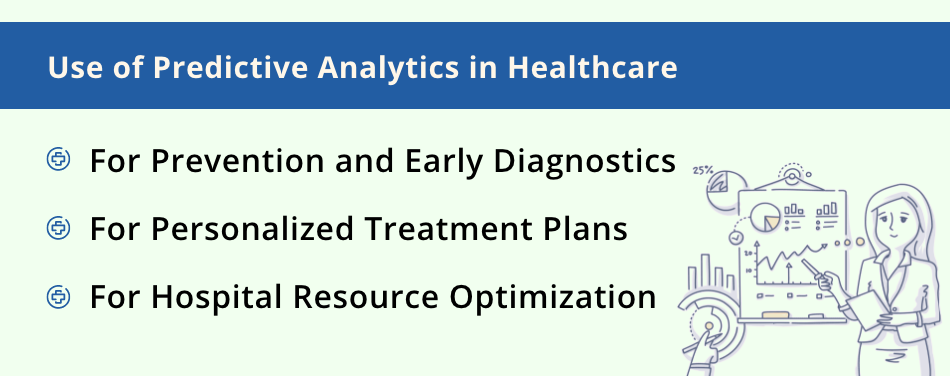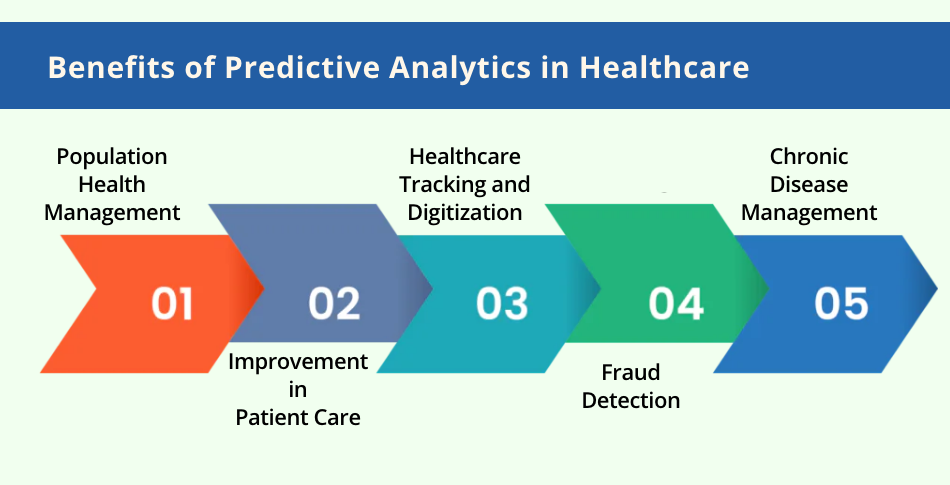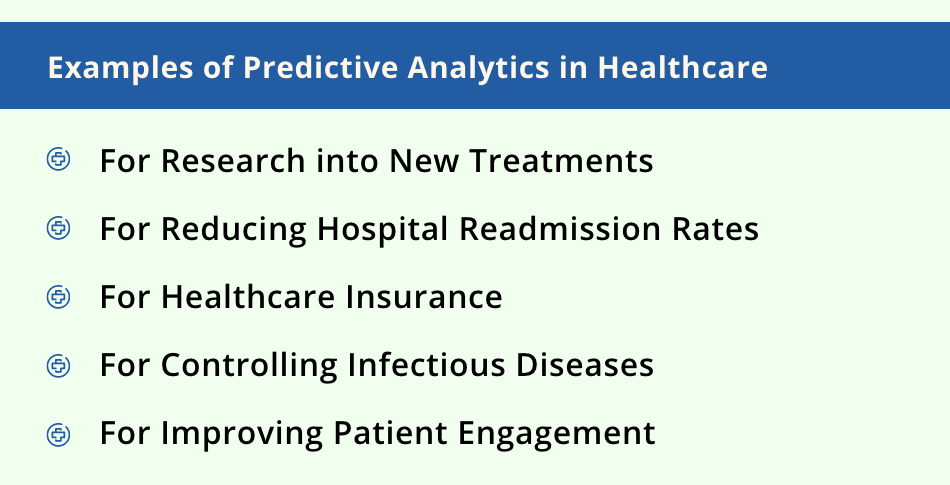Predictive analytics in healthcare uses real-time and historical data to make predictions about future trends, anticipate patient needs, and help healthcare organizations run more efficiently.
Updated 9 April 2024

Global Delivery Head at Appventurez
In a consistently evolving digital world, predictive analytics has emerged at the crossroads of healthcare and technology. This powerful tool deploys machine learning algorithms and statistical methods to analyze healthcare data and forecast future outcomes.
The application of predictive analytics in healthcare spans from preventing diseases to managing hospital workflows, further demonstrating the significance of this tool in healthcare application development services.
However, before diving further to understand how predictive analytics is altering the healthcare landscape, it is important to understand its role in the industry, the different applications of predictive analytics in healthcare, and how it is helping the industry enhance its operations.
Predictive analytics is a discipline in the data analytics world that relies heavily on modeling, artificial intelligence development services, data mining, and machine learning services.
The tool is used to evaluate historical and real-time data to make predictions. Predictive analytics in healthcare refers to the analysis of current and historical healthcare data. The role of this advanced technology in healthcare can be understood from the following points.
The use of predictive analytics in healthcare can be divided into three main categories:

Diagnostics is the area where the predictive models make a significant difference. Data-driven methods have taken diagnostics a few steps beyond the conventional approach, lifting the focus from the limited, traditional, test-based analytics to put it in a broader perspective.
Hospitals using predictive analytics also allow doctors to identify the patient’s bad potential and help early enough to stop the possibilities before they become a reality and develop into a serious illness.
Following the diagnostics, predictive analytics in healthcare make it possible to tailor a custom treatment plan for each patient, maximizing its effect. Personalized treatment strategies are particularly effective in fighting cancer and chronic conditions where one size fits all doesn’t always yield the best results.
A good example can be the impact of predictive data analytics on the treatment of cancer patients. Based on their history and genetic map, the oncologist can clearly understand the treatments with the highest healing potential.
Efficient management is one of the columns of a successful healthcare business. Predictive analysis in healthcare has an important application in this particular field, aiding in patient inflow forecasting and tactical resource allocation.
This method of healthcare predictive analytics also facilitates the hospitals in navigating an effective response to seasonal flu outbreaks, including staff shifts, number of beds, equipment, and management of medication inventories.
Some of the common types of predictive analytics used in healthcare are:
Technologies such as cloud computing in healthcare have transformed the way healthcare professionals operate and diagnose diseases. Similarly, the application of this advanced predictive analytics model helps in analyzing how a disease is likely to progress in an individual on the basis of various factors such as lifestyle, genetics, and treatment history. This information helps the healthcare professionals in tailoring the treatment plans and interventions for better outcomes.
Segmenting patients into different groups based on their health status, risk factors, or treatment plans allows for personalized care management strategies that are tailored to each group’s specific needs.
This type of predictive analytics in healthcare helps predict which of the patients are likely to follow their medication regimes and which are at risk of non-adherence. By following this model, which is also one of the prominent healthcare trends, professionals can intervene with adherence support strategies for at-risk patients, further improving treatment outcomes.
This type predicts future healthcare resource demand such as hospital admissions, emergency department visits, or intensive care unit (ICU) utilization. This helps the healthcare centers plan and allocate resources efficiently to meet the patient’s needs.
The process of predictive modeling in healthcare uses statistical methods, data mining, and machine learning to identify the patterns in data and recognize the chance of particular outcomes occurring. The points mentioned below further explain the predictive modeling process in healthcare:
The first stage of predictive modeling in healthcare involves the gathering of data from various resources. It also employs cleansing operations to remove noise further ensuring accurate predictions by extracting only the significant information.
Before building the model, it is important to first create a basic chart of your data and thoroughly analyze it. This process also offers significant clarity regarding the problem at hand and potential solutions, further providing a solid foundation for model development.
Sometimes, the data lends itself to a specific algorithm or model. As you analyze the data, run as many algorithms as you can and compare their outputs. Identify test data and apply classification rules to check the efficiency of the model.
To make the predictive model valuable, it is important to integrate it into the process of your healthcare organization so that it can be used to help improve patient care.
With the latest technological advancements, predictive analytics in healthcare has tremendously impacted the industry. Here are the most important ways through which predictive analytics has benefited healthcare institutions.

The most important benefit that predictive analytics brings to the industry is the accessibility to all types of data which provides the doctors with valuable insights that can also guide their decisions and lead to an overall improvement in the patient’s health.
Predictive analytics in healthcare isn’t only applicable at the individual level but also the healthcare organizations that can use it for population health management.
It can help in identifying cohorts exposed to a possible disease outbreak and facilitate the healthcare professionals to look for treatments immediately, which can improve people’s chances of survival.
The digitization of healthcare services has completely transformed the way that patients and healthcare professionals interact with each other, further empowering the future of telemedicine. Nowadays, we can also attach devices to our bodies and can track health and body performance at any given time from our mobile phones.
As per the reports, chronic diseases are one of the leading causes of death and disability in the US, as well as the main drivers of the country’s $3.5 trillion in annual health costs.
Chronic disease management, as one of the benefits of predictive analytics in healthcare, depends on the ability of healthcare professionals to prevent the development of these diseases as well as to control them. Predictive analytics can also empower healthcare providers to make fact-based decisions in order to provide more effective treatments while reducing costs.
Fraud in healthcare is a common problem, ranging from intentionally incorrect reporting of the diagnosis or the procedures to maximizing the payment. Predictive analytics in healthcare helps in identifying certain abnormalities that can flag these fraudulent actions, thus helping catch on to them early on.
Some of the prominent predictive analytics in healthcare examples are mentioned below:

With the use of socioeconomic data, EHRs, and predictive analytics, patients with a high risk of readmission can be discovered, warned, and provided with additional medical care to reduce readmission rates.
Predictive analytics in healthcare can be as effectively used in the research of new treatments too.
The predictive algorithms can accurately predict the person’s response to a medication or treatment plan based on genetic information, clinical history, and other data. This is one of the predictive analytics case study examples that can also streamline the research process and cut the need for patients for groups.
Among the rising technology trends in healthcare such as the use of artificial intelligence in hospital apps, predictive analytics healthcare can calculate the accurate cost of health insurance for each specific individual based on gender, age, insurance case history, heredity, etc. More so, predictive healthcare can also be used to prevent fraudulent insurance claims.
Controlling infectious diseases is another one of the prominent data analytics in healthcare examples. Predictive analytics has demonstrated significant prowess in controlling infectious diseases, further reshaping the approach to their prevention, management, and containment.
This technology, which is empowered by machine learning, provides a robust mechanism to anticipate and react to infectious disease outbreaks, even before they reach epidemic and pandemic proportions.
With predictive analytics in healthcare, the patient’s non-compliance can be detected in advance and active measures can be taken to keep patients healthy until the next appointment or treatment.
Healthcare providers can make effective use of predictive analytics in healthcare to design patient files that incorporate specially targeted communications and techniques that help in creating a better patient-doctor relationship.
The healthcare industry is undeniably overflowing with data- patient records, medical images, lab tests, research studies, pharmaceutical trials- and the volume of the information generated is enormous. This data holds the potential to bolster patient care, enhance resource usage, and address global health issues.
By collaborating with Appventurez, unlock the power of data across the health systems and the datasets with a robust healthcare data analytics solution.
Our team holds expertise in advanced predictive analytics that provide healthcare organizations with a real-time, contextual view of their data, further assisting healthcare professionals to deliver better by empowering them to make smarter and data-driven decisions.
Q. What are some of the problems with predictive analytics in healthcare?
Some of the common predictive analytics challenges in healthcare include data privacy and ethical hazards, ensuring data quality and integrity, and integration with existing healthcare systems. Notably, these hurdles must be navigated carefully to reap the full benefits of this transformative technology.
Q. What is predictive modeling in healthcare?
Predictive modeling, in particular, allows forecasting the course of the disease, further enabling medical professionals to avoid health risks like adverse reactions to the medicine, genetically determined resistance to the treatment, and failure to adhere to the regimen.
Q. Why is predictive analytics important in healthcare?
Predictive analytics allow healthcare professionals to quickly analyze the data and plan a course of treatment that will work best for their patients, further saving time and producing better outcomes.
Q. What are the key uses of predictive analytics?
Predictive analytics can be used to streamline operations, boost revenue, and mitigate risks for almost any business or industry, including retail, banking, public sector healthcare, and manufacturing. Sometimes augmented analytics are used, which uses big data machine learning.


Elevate your journey and empower your choices with our insightful guidance.

Global Delivery Head at Appventurez
Ashish governs the process of software delivery operations. He ensures the end product attains the highest remarks in qualitative analysis and is streamlined to the clientele’s objectives. He has over a decade of experience as an iOS developer and teams mentorship.
You’re just one step away from turning your idea into a global product.
Everything begins with a simple conversation.